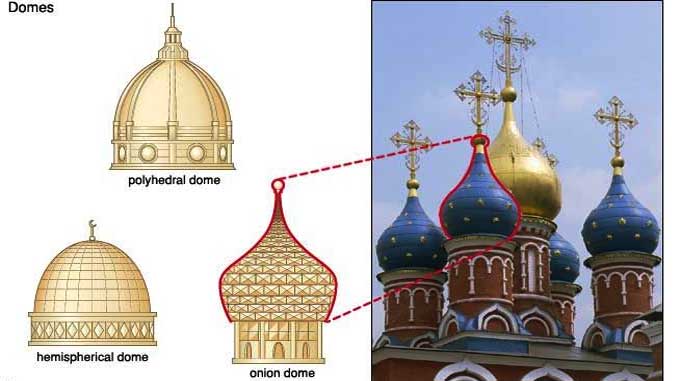
What you need to know about Domes in Architecture?

An architectural dome is a curved element that forms the top half of a sphere. There is no need for internal support in domes, and a great deal of area can be covered with very little material.
It is possible to build dome structures from a wide variety of materials, including the more common ones such as masonry and concrete, cast iron, wood, and steel, as well as the more unusual ones. Recently, lightweight materials, such as architectural fabrics and cable structures, have also been used to create domes.
Types of Domes
Cloister Vault: In their horizontal cross-section, these domes, also known as domical vaults, maintain a polarized shape as a result of their polygonal shape.
As a result of the curvature of its surface, it matches the different regions of the polygon it rests upon on which it rests; therefore, it is not considered to be a semi-sphere.
From the center of the arch, they have a constant spring point along a wall from which they are suspended. In Italy, the Cathedral of Florence is probably the most famous example of this type of construction.
Cable Net Domes: Cable net domes involve pin-jointed cables and struts that are eventually balanced by ring beams and walls or columns along the perimeter.
In the installation of roofs for large areas like indoor stadiums and arenas, the cable dome is the most effective system application. A wire net hung in the air supports flat fabric panels at the O2 Arena in London.
Hemispherical Dome: A circular ring beam supports one-half of a sphere, also called rotational domes. They are vertically compressed along their meridians, while horizontally compressed at locations above 51.8 degrees. To counteract horizontal tension, hemispherical domes frequently require buttressing below this point.
It is the Stockholm Globe Arena in Sweden that is a magnificent example of a hemispherical dome.
Beehive Dome: In addition to being one of the oldest types of domes, this structure is also known as a false dome or corbelled dome. Each layer is successively cantilevered or corbelled toward the center until a point is reached where all the layers come together. As masonry layers are cantilevered until they meet in the middle, they are not domes in the usual sense.
Monolithic Dome: One-piece monolithic domes have thin shells that are made of one piece. The form may be permanent or temporary and may or may not remain with the structure when finished. It is possible that the igloo is the first dome made from a single piece of stone.
Around the world, monolithic domes can be found in homes, businesses, and factories. They are utilized for massive storage in cement, fertilizer, agricultural, power, and mining sectors because of their strength, durability, and cost-effectiveness.
Geodesic Dome: Geodesic domes are constructed from triangles and resemble spheres. Triangles are used to create a self balancing structural framework for the dome that uses minimal materials.
Geodesics give their names to these structures, which are derived from polyhedra and tetrahedra. Effective resolution of a dome's internal stresses can be achieved by constructing these domes with simple elements and joints.
Onion Dome: An onion dome is a dome with a pointed top and an ogee shape that is larger than a hemispherical dome. Colorful paintings and gilded statues are often taller than they are wide.
Despite the dome's tendency to expand at its bottom, the bulging part is a buttress. Since they are normally constructed from masonry, they are less likely to be made of wood.
Since they are found throughout the Near East, Middle East, Persia, and India, they may not have had a single origin. One of the most famous examples of this is the Taj Mahal.
To learn more, watch the following video tutorial.
Video Source: Unraveling Architecture
Crossed Arch Dome: It is a type of ribbed vault that is unique in its kind: crossed-arch domes. Rather than intertwining the ribs, the vault forms shapes such as polygons or stars. There are numerous geometric motifs included in the designs, with the octagon being one of the most common.
Wrapping it Up
Originally, domes were constructed from arches and were only used for small structures such as huts and tombs, as some of them originated from arches. A dome is a dome that has the shape of a ball. As construction and design techniques have improved, domes have also become increasingly popular for the display of grand structures such as cathedrals, legislative buildings, and, more recently, recreation buildings during the summer.

Image Courtesy: kids.britannica.com

